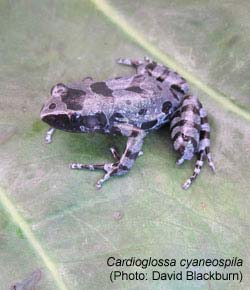Elusive long-fingered frog found after 62 years

Herpetologists from the California Academy of Sciences and University of Texas at El Paso discovered a single specimen of the Bururi long-fingered frog (Cardioglossa cyaneospila) during a research expedition to Burundi in December 2011. The frog was last seen by scientists in 1949 and was feared to be extinct after decades of turmoil in the tiny East African nation.
For biologists studying the evolution and distribution of life in Africa, Burundi sits at an intriguing geographic crossroads since it borders the vast Congo River Basin, the Great Rift Valley, and the world’s second largest freshwater lake, Lake Tanganyika. Many of the species in its high-elevation forests may be closely related to plants and animals found in Cameroon’s mountains, suggesting that at some point in the past, a cooler climate may have allowed the forests to become contiguous.
Previous knowledge of Burundi’s wildlife came from scientific surveys conducted in the mid-20th century, when the nation was under Belgian administration. But its history since then has been one of political unrest, population growth, and habitat loss. Today, approximately 10 million people occupy an area the size of Massachusetts, giving Burundi one of the highest population densities in Africa.
Academy curator David Blackburn joined his colleague Eli Greenbaum, professor at the University of Texas at El Paso, on the 2011 expedition with the goal of finding Cardioglossa cyaneospila, as well as other amphibians and reptiles first described 60 years ago. To their pleasant surprise, the habitats of the Bururi Forest Reserve in the southwest part of the country were still relatively intact, with populations of rare forest birds and chimpanzees present.
With little knowledge to go on except a hunch that C. cyaneospila would make a call like its possible close relatives in Cameroon, Blackburn finally found a single specimen on his fifth night in the forest.
“I thought I heard the call and walked toward it, then waited,” said Blackburn. “In a tremendous stroke of luck, I casually moved aside some grass and the frog was just sitting there on a log. I heard multiple calls over the next few nights, indicating a healthy population of the species, but I was only able to find this one specimen.”
The Bururi long-fingered frog is about 1.5 inches long, with a black and bluish-gray coloration. The males are notable for one extra-long finger on each foot, analogous to the “ring finger” in humans, whose purpose is unknown. Its closest relatives live in the mountains of Cameroon, more than 1,400 miles away.
The lone specimen collected, which now resides in the Academy’s herpetology collection, can be used for DNA studies to determine how long the Cardioglossa species from Burundi and Cameroon have been genetically isolated from one another. The results will shed light on Africa’s historical climate conditions, a topic that has far-reaching implications for understanding the evolution of life in the continent that gave rise to our own species.
In addition to locating the Bururi long-fingered frog, Blackburn and Greenbaum also documented dozens of other amphibians in Burundi, many of which had never before been recorded in the country. The team also discovered some species that may be new to science.
“Eventually, we will use the data from our expedition to update the IUCN conservation assessment for amphibians of Burundi,” said Greenbaum. “Because Burundi is poorly explored, we’ve probably doubled the number of amphibian species known from the country. Once we demonstrate that Burundi contains rare and endemic species, we can work with the local community to make a strong case for preserving their remaining natural habitats.”
About the California Academy of Sciences
The Academy is an international center for scientific education and research and is at the forefront of efforts to understand and protect the diversity of Earth’s living things. The Academy has a staff of over 50 professional educators and Ph.D.-level scientists, supported by more than 100 Research and Field Associates and over 300 Fellows. It conducts research in 12 scientific fields: anthropology, aquatic biology, botany, comparative genomics, entomology, geology, herpetology, ichthyology, invertebrate zoology, mammalogy, microbiology, and ornithology. Visit research.calacademy.org.
About the University of Texas at El Paso
The University of Texas at El Paso (UTEP) is a dynamic urban university that serves more than 22,600 students enrolled in 75 bachelor’s, 78 master’s, and 19 doctoral programs. UTEP is recognized nationally for its leadership role in changing the face of U.S. higher education. Its students, who are 78% Hispanic, mirror the population of this region and, increasingly, that of Texas and the United States. UTEP’s success in serving as a catalyst for economic development and quality of life in this region has also placed it in the national spotlight as a model 21st century U.S. research university.
Media Contact
More Information:
http://www.utep.eduAll latest news from the category: Life Sciences and Chemistry
Articles and reports from the Life Sciences and chemistry area deal with applied and basic research into modern biology, chemistry and human medicine.
Valuable information can be found on a range of life sciences fields including bacteriology, biochemistry, bionics, bioinformatics, biophysics, biotechnology, genetics, geobotany, human biology, marine biology, microbiology, molecular biology, cellular biology, zoology, bioinorganic chemistry, microchemistry and environmental chemistry.
Newest articles

Properties of new materials for microchips
… can now be measured well. Reseachers of Delft University of Technology demonstrated measuring performance properties of ultrathin silicon membranes. Making ever smaller and more powerful chips requires new ultrathin…

Floating solar’s potential
… to support sustainable development by addressing climate, water, and energy goals holistically. A new study published this week in Nature Energy raises the potential for floating solar photovoltaics (FPV)…

Skyrmions move at record speeds
… a step towards the computing of the future. An international research team led by scientists from the CNRS1 has discovered that the magnetic nanobubbles2 known as skyrmions can be…





















